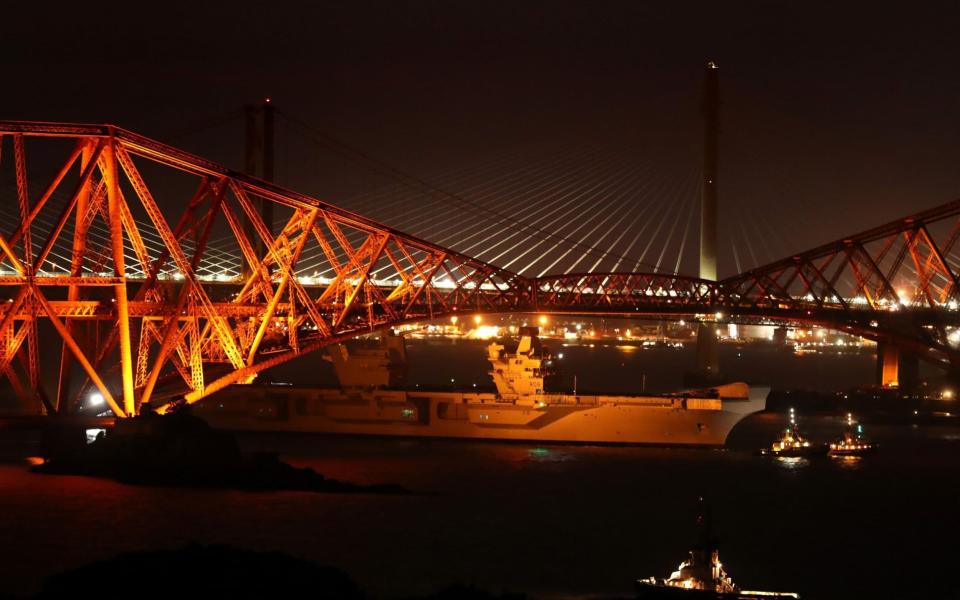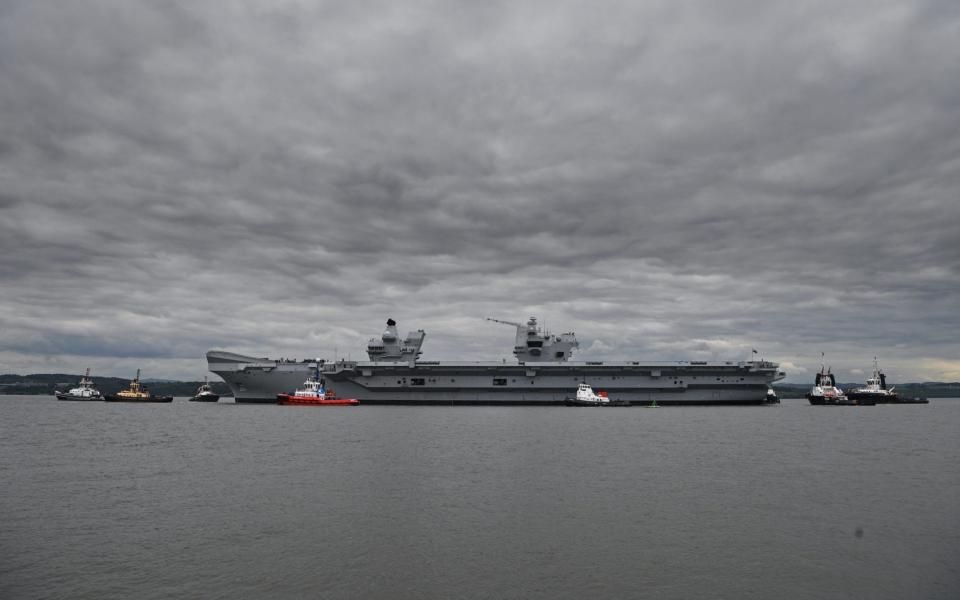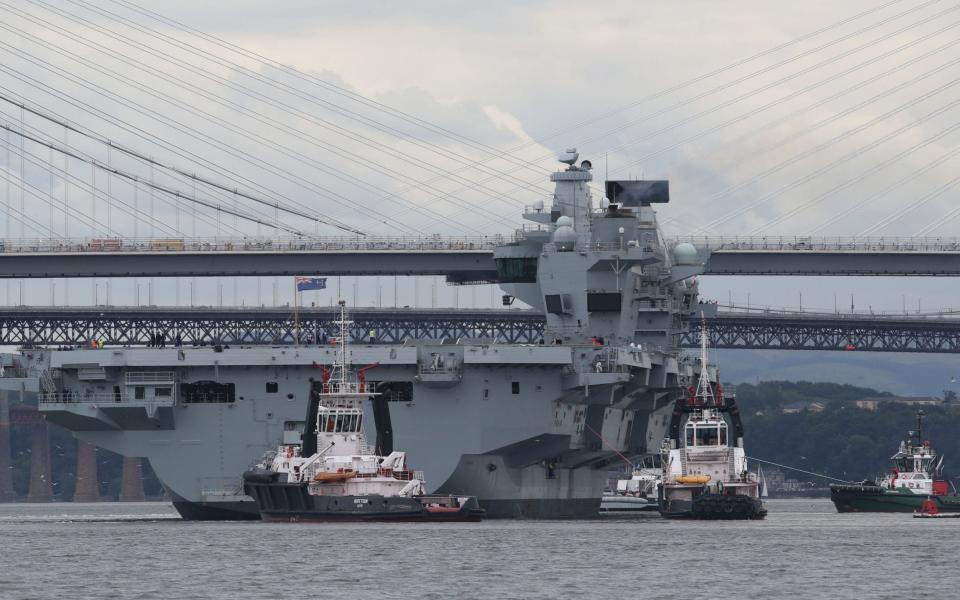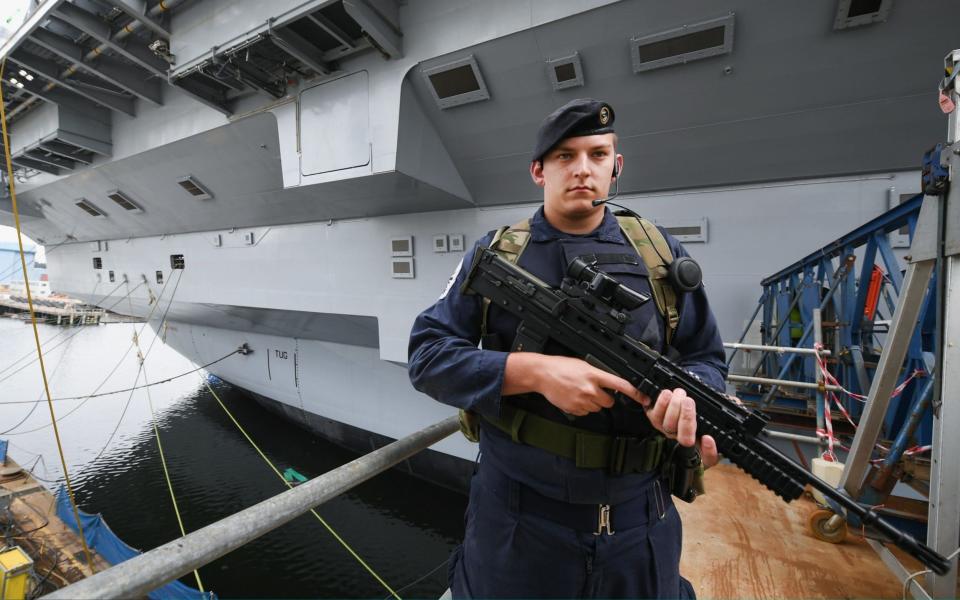HMS Queen Elizabeth sets sail for the first time for trials

With its tallest radar mast lowered to fit under the Forth’s bridges, Britain’s new flagship has set sail for its first trials.
The 65,000 ton HMS Queen Elizabeth slowly emerged from its dockyard into the Firth of Forth, bringing traffic to a halt on the road bridge, as car loads of ship enthusiasts tried to get a glimpse.
The largest warship Britain has ever possessed later used low tide to glide under the bridges shortly before midnight on Monday, before anchoring in Kirkcaldy Bay ahead of sailing into the North Sea.


The vessel was only able to fit under the bridge with a little over six feet to spare after lowering its rear radar mast, which has a built-in hinge for just such occasions.
Speaking before taking the ship out, Capt Jerry Kyd, commanding officer, admitted he would find it difficult not to duck instinctively when the Navy’s biggest ever warship passes under the Forth’s three bridges.

“It’s a bit like when you drive your car into an underground car park,” he said.
“You know when you dip your head, it’s exactly the same feeling as that.”
He said the headroom would be repeatedly measured with laser range finders in advance of passing under the bridges. But the final check would be made the old fashioned way.

He said: “The final check is me on an 1845 patent sextant so I know personally we can go under. I do that.”
The Navy is also prepared for the warship’s first appearance to attract a concerted Russian spying effort, with submarines, ships and planes expected to try to get a good look at the UK’s new flagship.
A Royal Navy warship escorted HMS Queen Elizabeth, while shore-based helicopters look out for submarines as commanders try out the warship in the North Sea and Moray Firth.
Cdr Fiona Percival, head of logistics on the ship said: “[The Russians] will come and look, but they look at everything.”
For the officer due to navigate under the bridges, it was not just their structures that bring a hazard, but also what they carry.
Lt Cdr Jez Brettell, navigating officer, said: “In Naval folklore, if a train goes over the top of the bridge as you are underneath, because in the days of steam the sanitary nature of trains was not as it is today, then the navigator had to buy a beer for everybody on the upper deck at the time, to compensate for the fact.

The 37-year-old from Wales said: “On an aircraft carrier, I am going to make sure the flight deck is completely clear when we go under the bridge, so that my round is as small as possible.”
The transit under the bridges was only the second part of the day’s manoeuvres.
The 918ft-long and 230ft wide vessel had first been guided out of the Rosyth dockyard basin where it had been built.
Rosyth pilots used tugs to guide the vessel out of a gap in the basin with only 14in clearance on each side and 20in of water beneath the keel.

Around 10,000 people worked on building the ship, which was made up in sections at six yards around the UK and transported to Rosyth to be assembled.
As HMS Queen Elizabeth left Rosyth, it left behind Britain’s second carrier, HMS Prince of Wales, which is still being built.
But the vessel will return for tweaks and adjustments after the first six weeks of trials.

Captain Kyd said: "After that we're going back out for a further three weeks to test the ship on the more war-fighting capabilities - the radars, all the ship's sensors, radios and things like that.
"At the end of that period we know that all the basics work. She's done her test drive and after that we will go down to Portsmouth, the ship's home, and get her finally ready to join the Royal Navy fleet, hopefully at the end of the year."
Adml Sir Philip Jones, the First Sea Lord, said the ship sailing was “a hugely significant moment for the Royal Navy, for all our Armed Forces and for our island nation”.

He said: “Once in service HMS Queen Elizabeth will be the largest aircraft carrier in the world outside the United States, and the first designed from the outset to operate a fifth generation aircraft.”
More than 700 Royal Navy sailors and another 300 contractors are embarked on the warship for the next six weeks, as they test the ship’s engines, and key systems.

 Yahoo News
Yahoo News 
